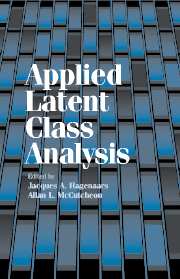Book contents
- Frontmatter
- Contents
- Contributors
- Preface
- INTRODUCTION
- CLASSIFICATION AND MEASUREMENT
- 3 Latent Class Cluster Analysis
- 4 Some Examples of Latent Budget Analysis and Its Extensions
- 5 Ordering the Classes
- 6 Comparison and Choice: Analyzing Discrete Preference Data by Latent Class Scaling Models
- 7 Three-Parameter Linear Logistic Latent Class Analysis
- CAUSAL ANALYSIS AND DYNAMIC MODELS
- UNOBSERVED HETEROGENEITY AND NONRESPONSE
- Appendix A: Notational Conventions
- Appendix B: Further Readings
- Appendix C: Selected Software; Webpage
- Index
7 - Three-Parameter Linear Logistic Latent Class Analysis
Published online by Cambridge University Press: 31 July 2009
- Frontmatter
- Contents
- Contributors
- Preface
- INTRODUCTION
- CLASSIFICATION AND MEASUREMENT
- 3 Latent Class Cluster Analysis
- 4 Some Examples of Latent Budget Analysis and Its Extensions
- 5 Ordering the Classes
- 6 Comparison and Choice: Analyzing Discrete Preference Data by Latent Class Scaling Models
- 7 Three-Parameter Linear Logistic Latent Class Analysis
- CAUSAL ANALYSIS AND DYNAMIC MODELS
- UNOBSERVED HETEROGENEITY AND NONRESPONSE
- Appendix A: Notational Conventions
- Appendix B: Further Readings
- Appendix C: Selected Software; Webpage
- Index
Summary
INTRODUCTION
The three-parameter linear logistic latent class model (3P-LCM) combines three well-known concepts in psychometrics: First, the concept of a discrete distribution for the subjects' latent ability or attitude, whereby the latent distribution is expressed by internally homogeneous classes (Lazarsfeld, 1950; Lazarsfeld and Henry, 1968); second, the concept of logistic regression for binary data (Cox, 1970; Cox and Snell, 1989), which traces back observed proportions to a smaller number of explanatory variables; and third, Birnbaum's (1968) concept of item-response theory, which allows different discriminatory power for the items as well as guessing.
The first and the second concepts have already been brought together in linear logistic latent class analysis (Formann, 1982, 1985, 1989, 1995), leading, among others, to the latent class/Rasch model; this is a latent class-model in which the latent response probabilities are restricted according to Rasch's (1960) model. Subsequently, this model has been shown to almost always become equivalent to the conditional maximum-likelihood approach in the Rasch model, provided that the number of classes is at least half the number of items (de Leeuw and Verhelst, 1986; Follmann, 1988; Lindsay, Clogg, and Grego, 1991). The 3P-LCM introduced in the following paragraphs can therefore be considered a generalization of the latent class/Rasch model in that it is enriched by discrimination and guessing parameters.
UNCONSTRAINED LATENT CLASS ANALYSIS
Assume that the subjects Sv,v = 1, …, N, responded to the dichotomous items Ii,i = 1, …, k.
- Type
- Chapter
- Information
- Applied Latent Class Analysis , pp. 183 - 210Publisher: Cambridge University PressPrint publication year: 2002
- 2
- Cited by



